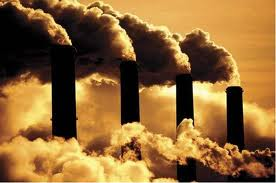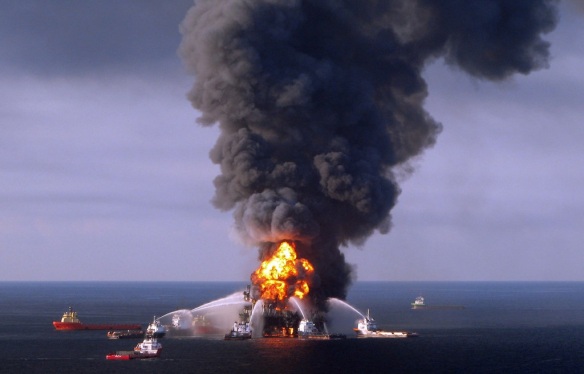A new report has found that limiting climate change to 2°C is not going to protect us from devastating sea level rise. According to the research, freshwater from land-based ice sheets melting into the oceans is inducing feedback that is accelerating the melting of ice shelves — a loop that indicates sea level rise will continue and could be devastating at much lower temperature changes than previously thought.
The study, authored by climate scientist James Hansen and 16 other researchers, will be published in Atmospheric Chemistry and Physics this week. The research explains that there is an “amplifying feedback” as polar ice melts, because as more freshwater enters the ocean, it traps warmer sea water, which melts more ice. The effect is not take account in the current climate change modeling but “extensive data indicate [it] is already occurring,” according to the report.
“We are underestimating the speed at which these things are beginning to happen,” said Hansen, head of the Climate Science, Awareness and Solutions Program at Columbia University’s Earth Institute. This feedback loop is separate from other accepted science, such as the ice-albedo feedback loop, in which dark-colored water and exposed ground absorb more heat than the white, reflective ice and snow they have replaced.
The implications of this feedback loop are significant, Hansen said “This is substantially more persuasive than anything previously published about just how dangerous 2°C will be”.
The study has not been peer-reviewed. Instead, it is being published in a discussion journal, which means will be published in full and made available to the public. Peer review and revisions will be made publicly. The scientific community is sure to express an opinion.

It’s Our Future Together http://www.planetfirstclothing.co.uk
Michael Mann, director of the Earth System Science Center at Penn State University, told ThinkProgress that he was “skeptical about some of the specifics” of the paper — for instance, the ocean current modeling and meltwater assumptions. But, overall, Mann supported the discussion the article will prompt.
“Hansen and colleagues make a plausible case that even 2°C planetary warming could indeed be very bad,” Mann wrote in an email. He pointed to the predicted collapse of the west Antarctic ice sheet and the substantial rise in sea level that would result.
“On that basis alone, the article serves as a sobering wake-up call to those who still dispute the threat posed by our ongoing burning of fossil fuels,” Mann wrote.
In fact, Hansen said “it’s the urgency of the issue that prompted him to submit the study to a discussion journal, rather than undergoing peer review, which might have taken too long.”
Instead, the study is appearing months in advance of the United Nations’ climate talks in Paris at the end of the year. Governments have already begun outlining their potential commitments to carbon emissions reductions, but Hansen suggested that current goals may not be sufficient to adequately address sea level rise. Other scientists have also criticized the 2°C limit, saying that it will not be sufficient to avoid catastrophic drought, flooding, and other climate impacts.
According to the authors the stakes could not be higher “High emissions will make multi-meter sea level rise practically unavoidable and likely to occur this century,” they write. “It is not difficult to imagine that conflicts arising from forced migrations and economic collapse might make the planet ungovernable, threatening the fabric of civilization.”
Three-quarters of large cities worldwide are located on the coast, making sea level rise a significant climate change risk. In order to prevent this process, we need to curb carbon emissions by 3 percent a year and increase carbon capture through agricultural and forestry practices. Hansen said “Putting a price on carbon is the most effective, and likely only effective way to address climate change and sea level rise”.
“The situation is more urgent than many politicians seem to realize,” he said. “What is really needed to happen requires that the major power decide we want to do this and we want to solve the problem and not just fiddle around the edges.”
At a meeting last month, leaders of the Group of Seven, a coalition of the world’s largest economies, agreed to limit warming to 2°C, but they did not announce a plan or mechanism for reducing emissions. China recently pledged to cut its carbon intensity i.e. its greenhouse gas emissions per unit of GDP, by 60-65 percent from 2005 levels by 2030.
The negotiations of the Conference of Parties (COP) in Paris later this year are broadly structured around an attempt to limit global warming to 2°C through voluntary, agreed-upon carbon emission reductions. Hansen and his colleagues believe that goal is a chimera.
The report authors conclude that “2°C global warming above the preindustrial level, instead of being a safe ‘guardrail’, is highly dangerous”.
Please share, post and tweet this Planet First Clothing blog.
Planet First Clothing
We are an independent eco-friendly company business, providing a lifestyle choice for young people concerned about the environment. Our garments are climate neutral, made from organic natural fabrics in ethically accredited factories.
For more information about Planet First Clothing check out the following:
Website: http://www.planetfirstclothing.co.uk
Facebook: www.facebook.com/PlanetFirstClothing
Twitter: @Planet_First
Instagram: www.instagram.com/planetfirstclothing
Pinterest: pfclothing
Blog: www.planetfirstclothing.wordpress.com
Email: info@planetfirstclothing.co.uk
Join the Planet First Clothing mailing list for up-to-date offers or just send us a comment using the form below:







